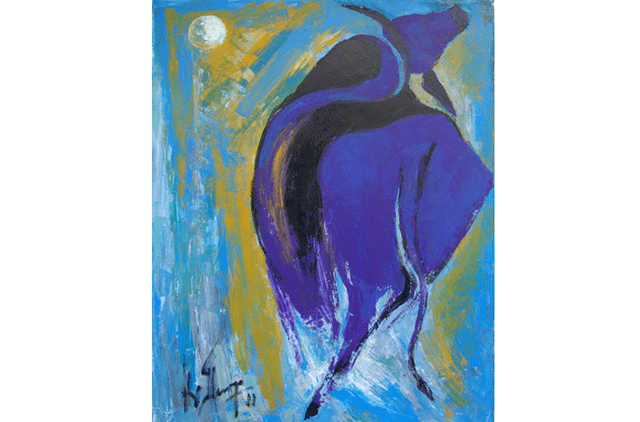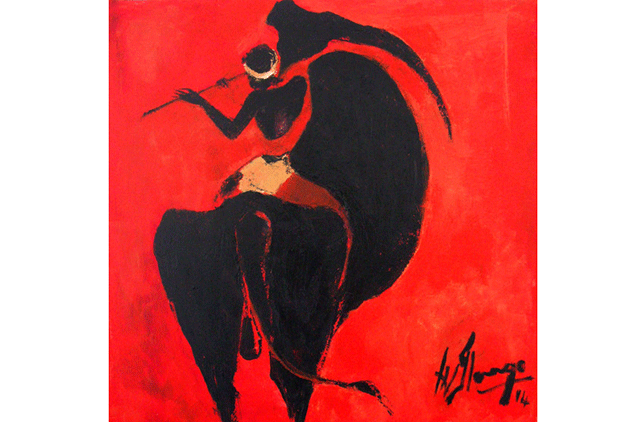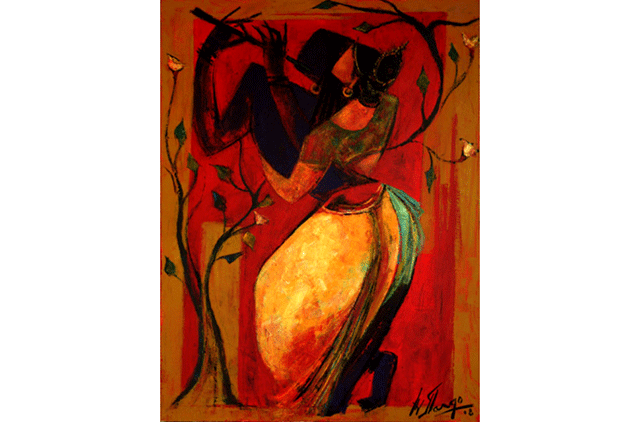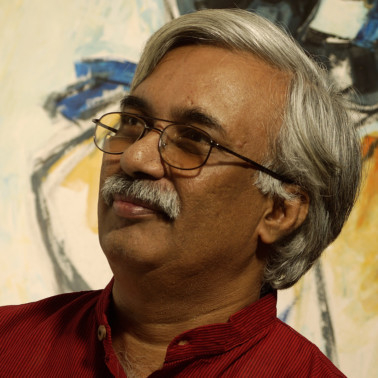
In artist A.V. Ilango’s words, “A sleeping line is like a poised lady, and when it is moving — a charged bull.” The drawings and etchings by this senior artist and mathematician from India portray mostly bulls in action. His new series titled “Jallikkattu”, is a Tamil word for the charged bull fight — a traditional south Indian sport that is an equivalent to the popular Spanish bull fight.
The 63-year-old mathematician and senior artist from Chennai says being an artist means being ready to take baby steps into spiritual understanding while studying one’s roles as an observer while holding his paintbrush.
Ilango spent his growing-up years — from the age of 7 to 16 — in Gobichettipalayam, a market town in the Tamil Nadu’s hinterland. The indelible impression of its picturesque setting — surrounded by paddy fields and coconut groves, canals meandering across the farms and hazy blue mountains framing the backdrop — is visible in his works even today.
He shares vivid memories of his time spent at farms and cotton fields. “I grew up very close to the bounty of rural abundance,” says the artist who gets poetic while talking of red-laterite-clay smothered men in paddy fields of his home town.
Ilango has vivid memories of his jaunts through fields with friends who grazed cattle, of chewing on cotton flowers and spitting them on the sidewalks, of exploring the mountains and hills with herds of cattle. He traces the bovine form and symbol as an idiom that has remained closely related to man, from prehistory to the modern era.
In India, art, culture, religion and rituals are interwoven in daily life. In traditional visual and performing arts, symbolism renders the classical arts more appealing for the initiated and the erudite while the folk arts are integrated by all in festivities.
Born and raised in a village that had several temples, the artist mentions the folk connection of bulls with Shiva, the hermit deity of Hindus. Ilango’s thoughts ran from Shiva to Nandi, his bull, to another deity, Krishna, and his mystical love symbolisms.
In his body of work the artist presents portraits of the charging bulls in iconic proportions. The Jallikattu series has the bull as a motif that features not only on his canvases but also on metal and stone sculptures.
This Chennai-based self-trained contemporary artist shows local concerns coupled with a pan-Indian sensibility. He has carved a niche for himself with his signature style and artistic intent. He influences the art world with his visual language and originality of expression.
According to him, the Jallikkattu is synonymous with the fight. And the fight is permanent, existing at many levels. He uses humour and political sarcasm to explain his point. “The jallikattu to ban the jallikattu sport is now between the people and the Tamil Nadu government ... and the pace picks up and falls depending on their moods and candidate [political nominee/party] preferences,” he says.
After living the realities of a bustling metropolis, his work has transformed to acquire a rather dark and gloomy tone.
Underlining his artistic processes, he says, “You really do not need inspiration to start. When you start, the inspiration takes over. From nothing everything starts. From a single point a line is born. Then from there forms and images .... And then it finishes to the point from where it all began. The end is again the reminder that it is over.”
His work is a reference to the nature of the artist’s engagement with a specific subject that is embedded in the consciousness of the people of South Asia.
The artist also conducts regular workshops for children in his hometown, and puts down the reasons as these: “There are three types of parents: those who want their kids to learn to draw so that their botany drawings improve; others want their kids to win drawing competitions; and the third set wants to develop their children’s creativity and lateral thinking. The last type come to me.”
Ilango’s message for the young people is a profound one and offers an escape route to the young generation, which is caught in the social “Jallikkattu”.
“When you get a moment to spare, do not look at your mobile and search for relationships. Instead, concentrate on the breath that you draw in and out. While you do that, draw your attention to the point between your eyebrows.”
About the artist
A self-taught artist, A.V. Ilango made his debut in 1973 on completing his masters in Mathematics from Bangalore University. Inspired by his childhood memories, he set off with a colourful palette. Colourful village life and the old town’s white-washed houses with red-tiled roofs that line the narrow streets — everything has influenced the artist’s visual compositions.
Married at 27, he migrated with his family from Bangalore to Madurai, the ancient seat of Dravidian culture. The architectural and sculptural splendours of Madurai’s temples fascinated him. He sketched the Meenakshi temple to execute paintings in the pointillist style, with monochrome tones highlighting the granite texture. Nataraja, Meenakshi Kalyanam and Rathi were inspired by the elegance of medieval classical sculpture.
The impressions of festivals and fairs were rendered with bold impastos. The contrast of the ethnic colours accentuated the linear quality on his oil paintings — Karagam, Kavadi, Oyilattam, to name a few of that early “Utsav” series.
In 1979, once again moving to Madras (now Chennai) in the pursuit of his artistic career, he found this big city hardly inspiring. It is the modern cultural and industrial centre. The noise, traffic jams, pollution, squalor and stench of this urban environment resulted in the dismal tones of his oil paintings titled “Aggression”, “Agony”, “Injustice”, “Ruins”, “Desert”, “Melancholy”.
To emerge from of that depressive phase, he changed his subject to create the “Rhythm 85” collection in joyous tones. At the end of the Eighties, Ilango allowed the urban influences to gradually evoke vivid figurations of artisans, workers, beggars harmonised with auto-rickshaws, buses, lorries, cycles.
Man, woman or a group of people at work, rest or in celebration, as subject of study, he preferred to depict the human form — elegant, tanned in the bright Indian sun, robust in dhoti and sari. The female head and torso were rendered in rotund forms. Inspired from the marapachi doll (brown wooden doll) and the giant kaval deivam (terracotta village guardians), Ilango conceived his human forms to arrive at harmonious compositions.
Light and dark tones were interlaced with subtle and bold lines. In the course of three decades, the residual forms, structural lines and monologous or analogous or complementary colour schemes culminated in his recent “Women” series. The last decade saw his palette mellow. The decorative elements disappeared. Minimalist compositions were etched in the sublime harmony of black and white, positive and negative spaces. Some works have caught the dramatic moment of an action. Whereas in others, forms merge into the space.
Apart from teaching mathematics in a medical college in Chennai for more than 25 years, A.V. Ilango has been teaching drawing and painting for almost 35 years.
In October 2004, he launched Ilango’s Artspace at 68 Cathedral Road, Chennai. In March 2006, it was relocated to Sir Muth Venkatasubba Rao Concert Hall Building, in the Lady Andal Secondary School premises at No 7, Harrington Road, Chetpet, Chennai.
This art space is not only his studio but a place where he nurtures creativity in other minds, from children to adults. The objective is the process of drawing and painting to express oneself in visual arts while enjoying the act of thinking and creating in an informal and personalised ambiance.
Ilango says, “Art lets you be in the now.” He believes in the traditional guru-sishya pedagogy. The learning is customised, based on the aptitude, sensibility and passion of the aspirants. Ilango’s Artspace showcases the young artists who practise under his guidance in India and abroad.
Known as artist B’lu, Archana R. D. is a freelance writer based in Dubai. She is also a student of global art business with the Sotheby’s.
















